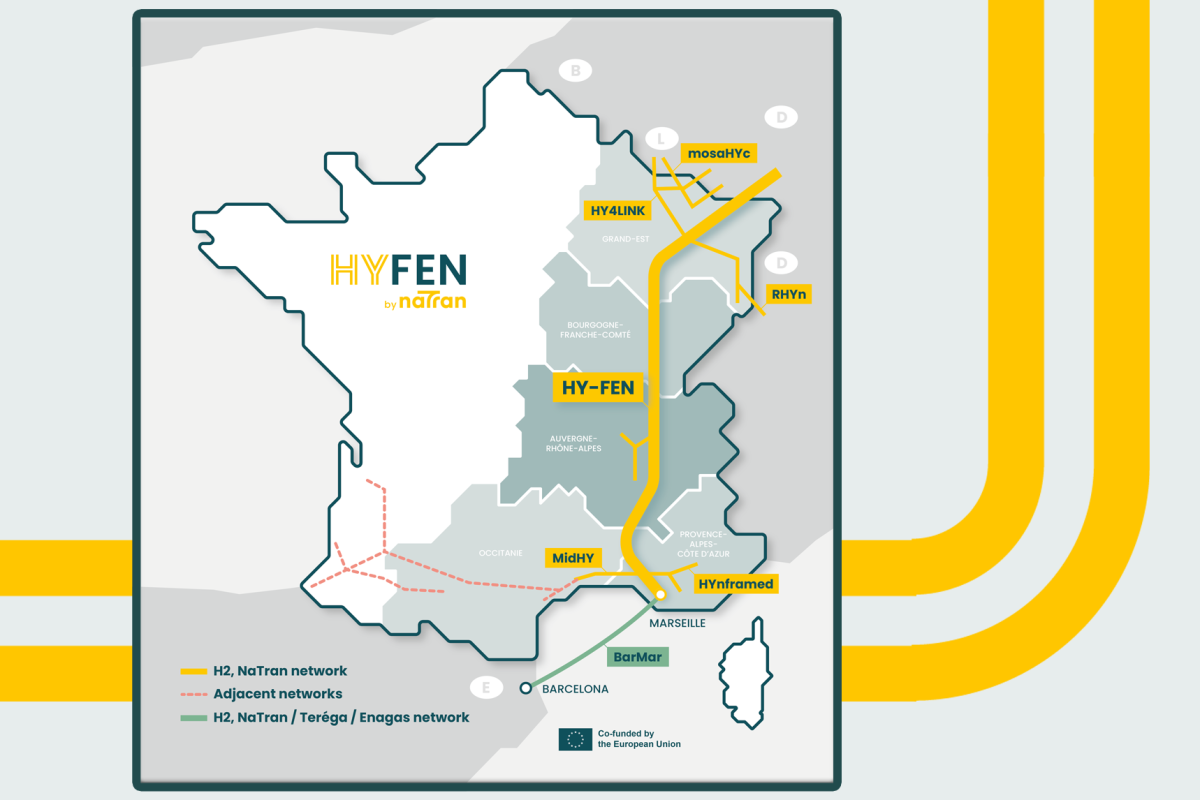HY-FEN

Last update: 1st October 2025
Description of project
HY-FEN is aimed at developing a hydrogen transport infrastructure from the south of France to the German border, in continuation of the BarMar project, connecting the Iberian peninsula, France and Germany via high-potential hydrogen valleys along its route in the Rhône valley, including major hydrogen storage projects.
This project is co-financed by the European Union:

Hydrogen for what use, planning and technical details
HY-FEN will enable the decarbonisation of the main industrial basins on its path in France and towards adjacent countries, in particular Germany. It will also be usable for the various mobility uses. Consequently, the project will be a key factor in the development of a renewable and low-carbon hydrogen market at the European level.
- 2020-2022: Preliminary studies for the design of a European hydrogen transport infrastructure as part of the “European Hydrogen Backbone”.
- January 2023: France and Germany announce the extension of the H2Med project up to Germany, confirming the benefits of a corridor.
- 2024: completion of feasibility studies
- 31 January 2025 : winning project of the Connecting Europe Facility (CEF) call for projects.
- 2025-2026: environmental studies
- 2025-2027: basic engineering studies for the direct Fos-sur-Mer – Obergailbach route.
- 2027-2029: detailed engineering studies and administrative procedures.
- 2030: From 2030: planned commissioning date.
- Length: Approximately 1,000 km at term.
- Capacity: 200 GWh/d.
The prefects of the departments involved in the HY-FEN project have issued prefectural decrees authorising preliminary studies to be carried out. These decrees allow teams appointed by NaTran (ecologists, surveyors, etc.) to carry out occasional work on certain sites to observe the environment, whether environmental, agricultural or topographical. The aim is to collect the data needed to define a corridor with the least impact, reconciling technical, agricultural and environmental issues as effectively as possible.
A project supported by the regions
On July 1, 2025, during the "Journées Hydrogène dans les Territoires" (Hydrogen Days in the Regions) held in Lyon, the 5 regions crossed by the project route - Auvergne-Rhône-Alpes, Bourgogne-Franche-Comté, Grand Est, Occitanie and Provence-Alpes-Côte d'Azur - affirmed their joint commitment to bringing this structuring project to life, an essential lever for the energy transition in the territories and the decarbonization of industry.
>>> Press release: Five French regions join forces for HY-FEN (July 2025)
>>> Video: Joint declaration of the regions on the HY-FEN project
Public participation
NaTran referred the HY-FEN project to the National Commission for Public Debate (CNDP). On 23 July 2025, the CNDP decided to organise a preliminary consultation on this project.
Four guarantors were appointed to ensure the quality, transparency and impartiality of this consultation:
- Mr Mathias Bourrissoux
- Mr Eric Taufflieb
- Ms Valérie Trommetter
- Ms Lucie Van der Meulen
This consultation is currently being prepared. Its terms and conditions will be specified and made public by the CNDP, which has entrusted its organisation to NaTran, the project owner.
The content of this publication is the sole responsibility of the author and does not necessarily reflect the opinion of the European Union or CINEA.